In 1990 The first production models of the Dynafit branded Tourlite Tech (TLT) began limited circulation in Europe. The binding became widely available around 1992/93 and was first brought to North America during that period. (The first “Dynafit” type bindings were made by inventor Fritz Barthel and sold under the Low Tech brand beginning in 1986.)
The unconventional and fragile looking Dynafit(Low Tech) backcountry skiing binding was slow to catch on. While it did save an immense amount of weight over other brands, changing the vertical release setting required taking the heel unit apart and swapping a spring, and the vertical release tended to behave as if it was higher than the numbers printed on the springs indicated. Nonetheless, devoted ski alpinists quickly realized that the Dynafit saved so much weight it could markedly enhance their uphill aerobic performance. More, the diminutive grabber was far from fragile. In fact, it was much more durable than many other ski touring AT and telemark bindings of the era. Vastly improved over the next decade but remaining true to the original design shown here, Dynafit is now the most popular alpine ski touring binding in the world.
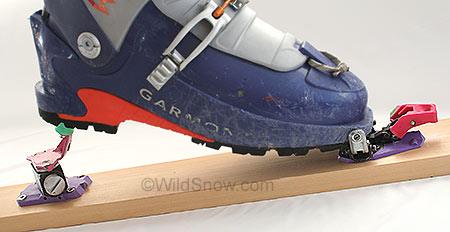
Complete 1993 Dynafit Tourlite Tech backcountry skiing binding shown above. The pink and purple color scheme is typical of late 1980s and early 1990s style.
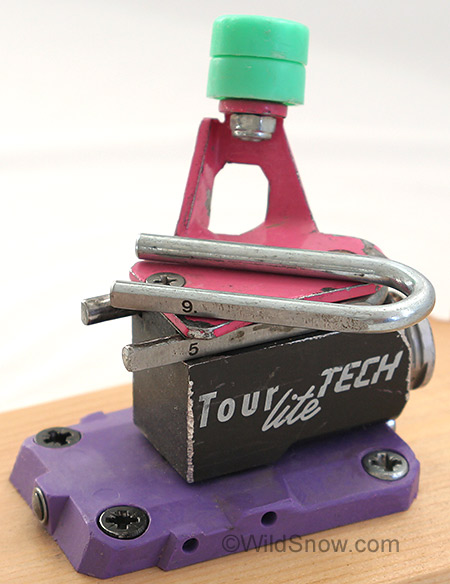
Heel unit with a DIN 5 vertical release spring, DIN 9 spring sitting on top is installed by removing the pink top plate and swapping.
Lateral (side) release is adjusted with a conventional barrel and spring slightly visible at the right end of the binding. As with many earlier models of Dynafit TLT, the original Tourlite is only adjustable for a small range of boot length (in this case, about a centimeter). The green disks on top of the heel lift post can be stacked for more height.
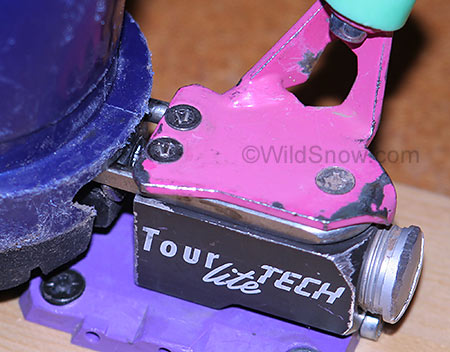
Detail showing how ends (rods/pins) of the release spring insert in the boot heel, which has a metal fitting the pins ride against.
For vertical release the tapered fitting forces the spring apart and the boot pops up and out. Today’s Dynafits work exactly the same way, only the release is adjustable with a screw driver instead of a spring swap.
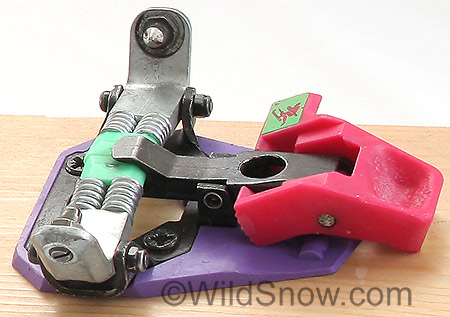
Toe unit is nearly identical to today’s Dynafit models. Main difference is that the wings could be taken apart by removing threaded fasteners (current ones are riveted).
Main difference from most of today’s tech binding is that the wings could be taken apart by removing threaded fasteners (current ones are riveted). The pivot pins that insert into the boot toe holes were also removable, presumably to ease their replacement if they wore out. Wear has not proved to be a problem with Dynafit pivot pins, and current model’s are swaged in and not removable.
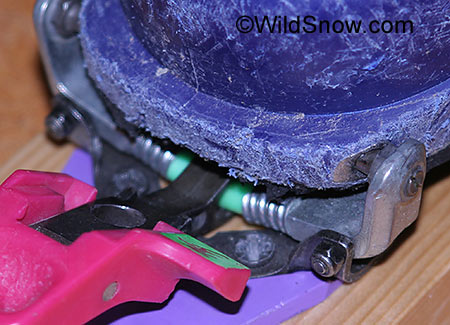
Toe detail showing how pivot pins insert in boot toe fittings/sockets. In lateral release the pins ride out of the tapered sockets.

Binding without boot. If it looks minimal that’s because it is. In all, one of the great technological advances in modern skiing.
History of the Dynafit (Low Tech) Binding as of 2015
Dynafit bindings (and other “tech” bindings”) are enormously popular. All accounts report hundreds of thousands sold throughout the world, and one of the binding co-inventors told me they sold more than 13,000 pair a year during the late 1990s and 2000s. They are used by everyone from weekend warriors, to guides logging hundreds of thousands of vertical feet, to competitive ski mountaineering “skimo” racers who treat ski mountaineering like a stair master workout.
In the mid 1980s, rumors circulated of people who were experimenting with building binding parts into ski boots. The goal was to eliminate redundant parts, especially the plate that connected most randonnee binding’s toe and heel units. Rumor held that people were building the spring bars from a Ramer backcountry skiing binding into a boot, so all you needed on the ski was a heel unit and the toe pivots from the Ramer (Ramer binding museum displays.)
As it were, a Tyrolean father son team (of Austrian nationality), both mechanical engineers, were inventing the TLT binding in their garage (the binding was then known as the “Low Tech”.) Manfred Barthel, the father, supported his son Fritz who went through years of intense research and development to come up with a workable and durable unit they could sell to the public. For the first prototype constructed in 1983-1984 they indeed used Ramer parts for mockup, and subsequently tested their designs in Europe and during trips to Canada. The Barthels, inspired as they were, took the concept of using the boot as the binding plate and refined it to an astonishing degree.
In the mid to late 1980s the Barthels made the binding themselves and retrofitted the boot fittings in a small factory in the basement of their family home. At that time they called the binding “Low Tech,” which is still the name of Fritz Barthel’s engineering consulting business. For boots the Barthels picked a Dynafit touring model that was lightweight and functional, and thus developed a relationship with the Dynafit boot company, who then purchased rights to brand, manufacture and sell the Barthel Low Tech binding (as well as selling boots with the fittings factory installed.) The binding was eventually named “Dynafit” once the Dynafit company began handling it.
The Dynafit company and brand was founded in 1950 (bought by Kneissl in 1995 and now owned by Salewa), and produced excellent alpine ski boots for years. In 1983 Dynafit introduced the classic red Tourlite randonnee AT ski boot. This boot was a fraction of the weight of other backcountry skiing boots, skied as well, was quite warm, and even doubled as a decent winter climbing boot (Colorado’s Gary Neptune climbed Mount Everest in his). This was the boot the Barthels picked for installing their binding fittings, and the boot Dynafit later sold with the fittings factory installed.
In the beginning, the Barthel family operated a coffee shop out of their house in Bad Haering, Austria. Fritz Bathel had a fully featured workshop in the basement, where he developed the binding.
When the Barthels decided to go commercial with their binding, they had to hand-install fittings in the ski boots. They soon got Dynafit to supply boots with the toe fittings molded in, but still had to mill the heel fittings. At one time around 1986 the Barthel house stored around a thousand pairs of Dynafit boots awaiting fitting installs and customers.
“The boots filled the house from basement to attic,” said Fritz in a 2010 interview by this author, “the thing was, we didn’t have any customers…” That was soon to change as the “tech” binding system steadily gained popularity due to its astounding lack of mass and excellent durability.
Eventually, the Dynafit boot company licensed the complete system from Fritz. Installing and marketing it themselves.
The Dynafit brand was bought by Salewa in 2003 and resurrected as a ski touring equipment company that included the Dynafit binding.
The Dynafit TLT binding was first brought to North America in 1993, and while not immediately popular was adopted by a few savvy ski mountaineers and gradually grew in favor with skiers worldwide. Manfred and Fritz Barthel deserve a huge amount of credit for bringing their binding to market, then refining it over the next decade. And let’s not forget Paul Ramer, who’s ball-and-socket binding concept was inverted and shrunk to create the pivot mechanism for the Dynafit.
Weight: One 1993 TLT binding with screws, no safety strap or brake, 12.3 oz., 348 g
(Current model TLT weighs a few grams more.)
These bindings were provided to Lou Dawson in 1993 by Lock Miller, owner of Marmot Mountain Works. Lock was the first North American retail importer of the Dynafit binding. Thanks Lock!

Dynafit Tourlite 1992 thumb.
